You’ll now easily find mini PCs powered by Intel Apollo Lake processor, but many of them are actively cooled, and only support HDMI 1.4 output limited to 4K @ 30 Hz. MeLE PCG03 Apo, an update to the company’s PCG03 fanless mini PC, is powered by an Intel Celeron N3450 quad core processor, support HDMI 2.0 video output up to 4K @ 60 Hz, and is passively cooled. On top of that, it can also be upgraded with an M.2 SSD. The company has sent me a review for sample, and while I’ll focus on testing HDMI 2.0 support, audio pass-through, and whether the mini PC can handle high loads without CPU throttling in the second part of the review, I’ll first have a look at the hardware design today.
MeLE PCG03 Apo Unboxing
I’ve received the device in the usual black retail package showing the key features with 4K UHD, HDMI 2.0, dual band WiFi, and USB type C.
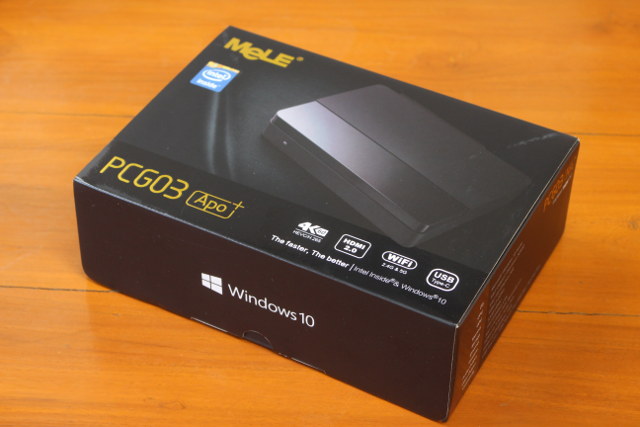
We have a quick rundown of the specifications on the side of the package.
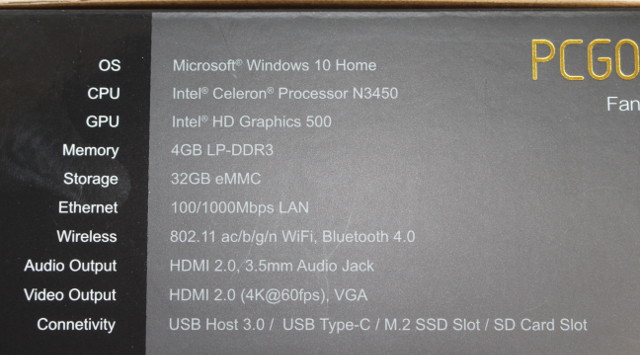
The mini PC shops with a user manual in English, as well as a 12V/2A power supply with US, EU, UK, and AU plug adapters.

The case design is the same as the older model with the top part made of plastic, and the bottom and rear panel made of metal.
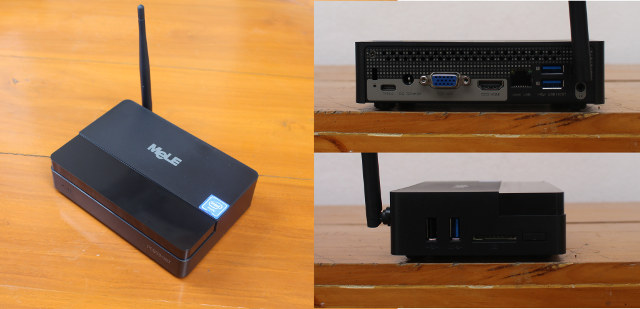
The front panel only comes with the power LED, and a window with the IR receiver. One of the side features a USB 2.0 port, a USB 3.0 ports, an SD card slot, and the power button, while the rear panel comes with a USB type C port (supported features not documented), the power jack, a VGA port, a HDMI 2.0 port, Gigabit Ethernet, two more USB 3.0 ports, a 3.5mm headphone + microphone jack, and an external antenna.
MeLE PCG03 Apo Teardown
Since customers may add there own M.2 SSD, the device has been made easy to open, and you just need to loosen 4 screws on the bottom plate, and 2 screws on the rear panel, and the top cover should come off easily.
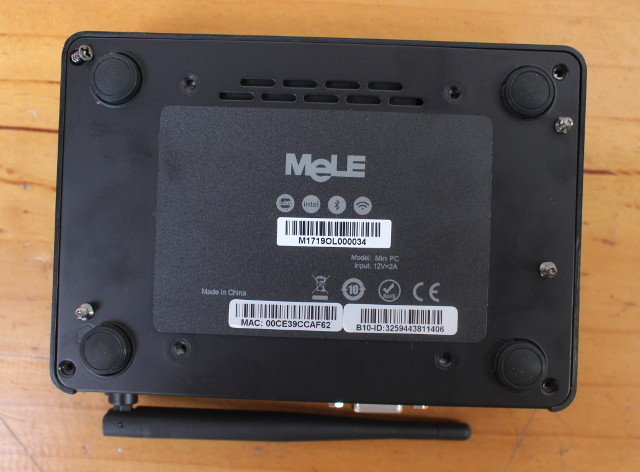
We can see a large heatsink covering the processor, memory and eMMC flash, a battery with a button to clear the CMOS on the bottom left, and a SATA connector on the right. It’s not really usable, at not least not easily in this enclosure, so it may have been designed for another model with a 2.5″ SATA bay. We’ll find the M.2 connector on the right of the board, and on the left of the SATA port, as well as a spacer and screw to keep M.2 80mm SSD card into place.
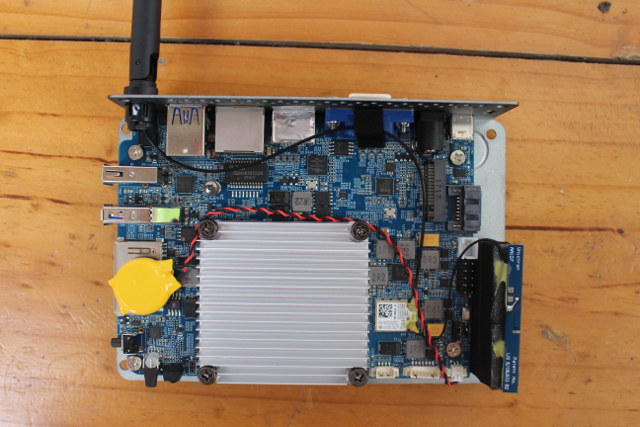
They’ve built a “wall” to elevate the internal antenna connected to the wireless module to provide a better signal, and possibly avoid the metal part to interfere / block the WiFi signal. Three unused connectors and headers are also found in this area with a fan connector, a 7-pin connector, and an LPC header. A jumper is used to select
“auto” or “normal”, probably referring to boot mode.
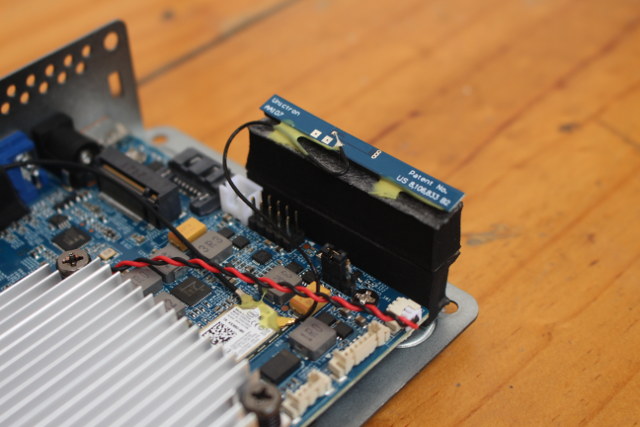
I’ve taken out the four screws and springers on the heatsink, but it would not come out, and I also further loosen four screws that seem to hold the main board on the metal part of the case, but again it would stay firmly in place. So I gave up, as I did not want to damage it before the review.
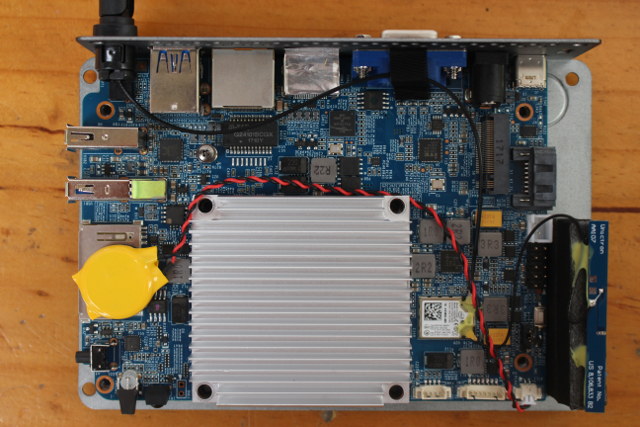
It’s still interesting to check out the board, and the various notable chips on the board. From top left to bottom right:
- Realtek ALC269 audio coded for the headphone jack
- M-TEK G24101SCGX Gigabit Ethernet transformer
- ParadeTech PS175HDM DisplayPort 1.2 to HDMI 2.0a converter
- ITE IT6513FN DisplayPort to VGA controller
- Realtek RTS5170 card reader controller driver
- Richtek RT5074A, probably a power management IC
- Intel 3165D2W wireless module for 802.11 b/g/n/ac WiFi and Bluetooth 4.0 LE
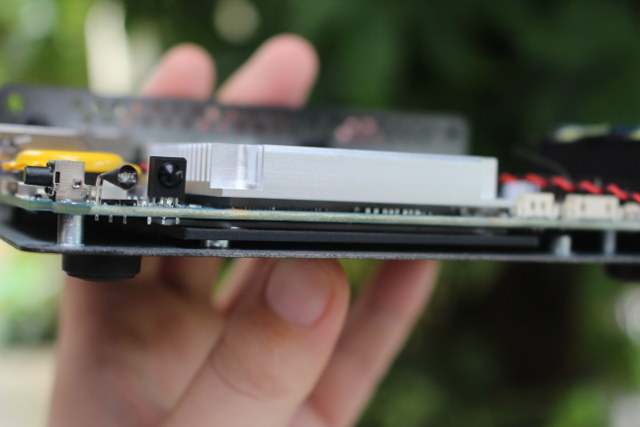
I also took a side shot to show the different measures taken to cool the board with apparently a heatsink and thermal pad on the top, and another thermal pad, and thick metal plate connected to the bottom metal case.
I’d like to thank MeLE for sending their latest mini PC for review, and if interested, you can purchase it for $159.20 including shipping on their Aliexpress store.
Continue reading “Review of MeLE PCG03 Apo Fanless 4K Mini PC – Part 2: Windows 10, Benchmarks, and Kodi“.

Jean-Luc started CNX Software in 2010 as a part-time endeavor, before quitting his job as a software engineering manager, and starting to write daily news, and reviews full time later in 2011.
Support CNX Software! Donate via cryptocurrencies, become a Patron on Patreon, or purchase goods on Amazon or Aliexpress. We also use affiliate links in articles to earn commissions if you make a purchase after clicking on those links.




Great job. M.2 ssd is a most welcome surprise as its not listed on website specs. Maybe you can test if it’s compatible with the Samsung 950 NVME ssd and show benchmarks.
I can’t wait for your follow up review as I hope to buy this purely for HTPC use. I’m glad you will be looking into thermal and potential audio pass problems that have plagued the Intel NUC’s. 4k60 with hd audio decoding is going to be demanding and the cooler doesn’t look like it’s going to be upto the job.
Could addon fan help as you mentioned their is a connector for one ?
Also Melec mentioned optionsl 8gb model on website.
Can you please enquire about its availability as it seems the 4gb is non upgradeable. Maybe you can have another go taking of the heat sink after you have completed second review.
We might be lucky and find another slot for additional ram underneath it ?
@Archy
I don’t have M.2 SSD, but maybe I could get one before the second part (Around mid July).
4GB RAM should be more than enough for HTPC use. There would be no space for a SO-DIMM slot underneath, the RAM is non-upgradeable.
@cnxsoft
July is going to be a long wait lol
Hopefully Mele will keep the special price running until than.
Please enquire with Mele about 8gb model as listed on their website.
Also do Mele release bios updates etc ? I couldn’t find support section on their website and maybe you know of a support forum for their products.
@cnxsoft
If you want to buy M.2 SSDs you would need to buy both types: SATA and PCIe 😉 (M key supports both but I would assume the CPU’s 2nd SATA port is used here)
@Archy
There is a forum: http://forum.mele.cn/forumdisplay.php?fid=1
I don’t think they do bios updates, surely not for the PCG02U.
In the past MeLE sometimes provided enclosure tops where you could insert a 2.5″ disk. The PCB providing both SATA and 5V power connector could provide the same: http://linux-sunxi.org/Mele_A1000G_Quad#Pictures
@tkaiser
Good point. Anyway, I’ll ask MeLE which one is supported before getting one.
@Archy
MeLE has relatively decent support. They released Windows 8.1 recovery ISO and the drivers for MeLE PCG03. I have not seen the BIOS though.
@tkaiser
That was the old models. This blog started getting traction thanks to MeLE A1000 Android TV box, and efforts to port Linux to it. But I don’t think they use that form factor in new models anymore.
Yeah, I know, just wanted to point out that they could easily do the same now just by providing another enclosure top with the long known mechanism since everything prepared on the PCB already. Really looking forward to your review and especially interested in ability to run Linux, dimensions of power barrel, which GbE chip is used and how (PCIe or USB3), M.2 SATA or PCIe, idle consumption.
Since this device will be fed with 12V one could use it with 2 3.5″ SATA disks (given M.2 is SATA and only needs a mechanical converter). A 12V/4A PSU should do since 5V are available on the JST XH 2.5mm header (if it’s the same os an the old MeLE). You said next part of the review will be finished… on sunday? 😉
BTW: Above pictures from MeLE A1000G are mine, I was really frustrated after opening the thing since I thought I ordered one with A20 and real SATA but got crappy A31 with even more crappy GL830 USB-to-SATA bridge 🙁
I already asked them some time ago if they will release one without OS or with linux, but they said this was not planned for the moment. Probably their U-models didn’t sell very well.
According me there is room under the top cover to put a 2.5hdd.
@roel
Thanks.
Not encouraging that they don’t do bios upgrades. One can only hope that Mele DPI>HDMI solution works perfectly as the Intel NUC’s didn’t until numerous bios upgrades which are still happening. It’s also unfortunate that the chip used to bridge DP and HDMI isn’t the same one as Intel NUC’s so cross bios/FW can’t be applied to fix potential issue.
This could be a great HTPC solution or a complete waste if HDMI implementation is not implemented correctly.
pity there’s no S/PDIF out, as that would be useful for HTPC.
@roel
PCG02U was their top seller on Aliexpress. MeLE only sell a few thousand pieces for all their products combined via Aliexpress, so that’s not representative of their actual total sales, but still.
However, I can see they’ve now removed all Ubuntu mini PCs from their store.
@roel
Yes, there may be enough room to fit a 2.5″ drive inside, but nothing to hold it in place, so you’d have to manage that yourself. It may also lead to overheating due the heat from the hard drive itself, and it would block some of the ventilation.
So I’ve asked a bunch of questions to MeLE and here are the answers:
Follow up email:
They’ve also been reading your comments and released PCG03 Apo firmware, drivers, and BIOS:
@cnxsoft
MeLE’s answers sound promising. Care to ask which GbE chip they hide below the heatsink?
According to ark.intel.com this Celeron supports up to 3 displays so maybe asking whether the USB-C supports DisplayPort or even HDMI Alternate Mode and if so preparing this for your review testing dual display capabilities?
@tkaiser
So for as I know, USB TYPE-C is just for data transfer (in their YouTube video), not for display.
HDMI 2.0 and VGA are both converted from native DP1.2 on Celeron N3450, which enables dual display on a TV(HDMI) and Monitor(VGA).
@Eric
Hmm… VGA is nothing I would use for (dual) display since it sucks but it’s nice to have it thinking about using this device in conference rooms (so many projectors still rely on VGA). Pity there’s just a stupid ‘TYPE-C’ written at the back while ‘Conetivity information’ on the box also mentions nothing relevant (it might be even just USB2 Hi-Speed data lines exposed to the outside if they don’t use the appropriate logos that have been defined almost 2 years ago!)
@cnxsoft
Looking forward to this:
1. …we will release next model in August which will have slots for both DDR and SSD so that you can upgrade hardware configuration as wanted.
3. The next model will support 2.5” SATA HDD which will use the same PCBA as PCG03 Apo but in another case.
Thank you for the info!
@sabai
Since you seem to speak for MeLE what about answering the remaining questions? Which GbE adapter is used (RTL8211? Intel I210? Something else?) and what’s available at the ‘TYPE-C’ connector? Hi-Speed, SuperSpeed, even Alternate Data Modes?
So why buy one of these when the Zotac ZBOX CI327 nano with a Celeron N3450 in a much better quality box with space for a 2.5 inch disk and two Gigabit ethernet ports (Realtek controller) is available for about USD 160 (barebones) for which one can supply one’s own choice of memory brand and size?
It was mentioned back in April but there was no unboxing, teardown, and review as for this product.
@Arthur Frayn
Mostly because it’s quite cheaper, although it depends where you live.
I can only find Zotac CI327 Nano in Europe now for as low as 169.90 Euros including VAT and shipping. Once you factor shipping costs, equivalent memory and storage, you’ll add around 60 Euros. So that’s around $250 in total for a Zotac ZBOX CI327 nano with the same amount of memory and storage, but at least if you live in Europe, you don’t have to worry about customs.
@cnxsoft
Thanks for the abundance of useful information.
I was wondering if you can find out if Mele have HD audio pass through working properly using DP>HDMI as this has posed many problems with Intel Apollo NUCs. And will the revised box in August still have M.2 or will it be dropped for SSD only – seriously hope not.
This will than just leave than just leave the concern if cooling has been implemented adequately to avoid thermal choking. Smooth 4k60 with pass through HD audio and we could end up with the perfect HTPC at its excellent price point.
I also considered the Zotac ci237 Nano but it is way more expensive in the UK at £195 barebones and a little cheaper to import from EU which is still headache for support issues etc. Zotac doesn’t have m.2 SSD port which I much prefer over SSD for HTPC.
@cnxsoft
That’s where we started.
@Tom Cubie
Yep, and nice to see you’re still around 🙂
@tkaiser
Yes, I also think they should correct the logo and silk print on the product for the USB Type-C.
BTW, I suppose cnxsoft already mentioned some key components used on it in this post, such as:
– Realtek ALC269 audio coded for the headphone jack
– M-TEK G24101SCGX Gigabit Ethernet transformer
– ParadeTech PS175HDM DisplayPort 1.2 to HDMI 2.0a converter
– ITE IT6513FN DisplayPort to VGA controller
– Realtek RTS5170 card reader controller driver
– Richtek RT5074A, probably a power management IC
– Intel 3165D2W wireless module for 802.11 b/g/n/ac WiFi and Bluetooth 4.0 LE
@Archy
It seems that the HD passthrough via Kodi on its previous model PCG03 (Intel BayTrail) is possible. Maybe it is also working on this Apollo Lake model. Waiting more reviews or feedbacks…
@Eric
I know what Jean-Luc mentioned but I’m still asking for type of the PCIe GbE adapter hidden under the heatsink (and hope for at least Intel I210) and what’s possible with the USB-C jack.
@tkaiser
I assume the GbE chip will show up in the Device Manager in Windows.
Eric – who actually works for MeLE – mentioned above the USB C only supports data, no video.
@tkaiser
Hi, yes, I just work for MeLE to manage its forum. Maybe I can help you to ask MeLE for something.
For the LAN port, it uses RTL8111GN from Realtek as MeLE answered me.
@Eric
Thank you for the answer (though not the one I hoped for –> at least Intel I210 or BCM57762 instead of RealTek).
Anyone managed to buy one yet ?
I’m looking for confirmation on HD audio pass through working and any thermal throttling issues with 4k60 playback.
Will it have the longer antenna when I order one at Aliexpress today?
Hi!
I see there’s a SATA connector onboard. Have you tried to boot up from regular SATA drive connected to this port (not m.2)? Is it possible to install linux directly on this drive?
Thanks, Boro
@Boro
Not tried on PCG03 Apo. PCG35 Apo should be a better option, as you can mount the 2.5″ drive inside the case.
@cnxsoft
Just got PCG03 Apo. It is possible to attach regular SATA disk to SATA port. I was able to install a linux OS there and then boot from this port.
There’s a huge problem with SATA power, though. Onboard SATA power (5V) socket is rotated 180* which causes wrong polarity applied to hard disk! This caused that Mele board woudn’t start and caused a quiet noise from attached SSD. This can cause a hard drive damage. The plastic cover can be easily pulled from two SATA 5V pins and moved back on rotated 180*, but this is inacceptable. I can provide photos explaining this situation in detail.